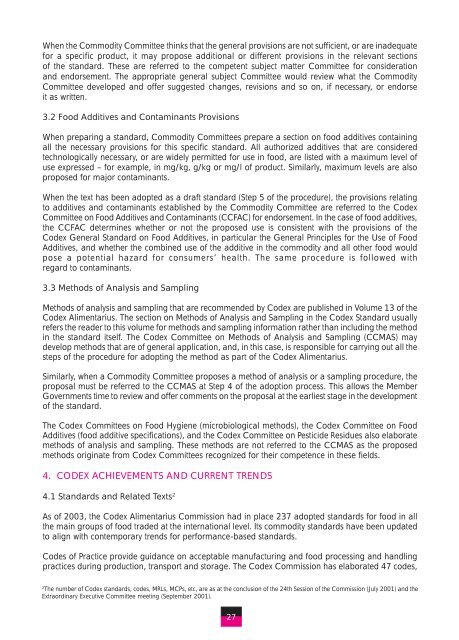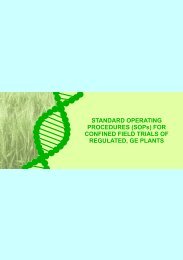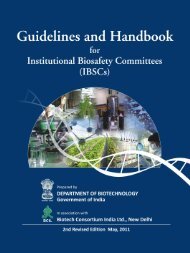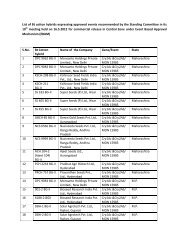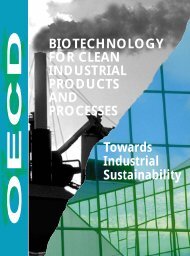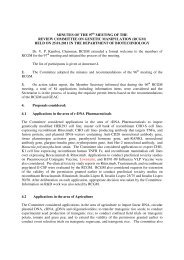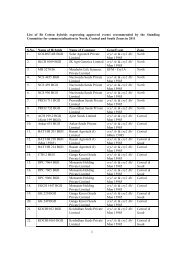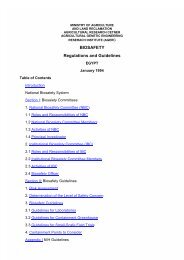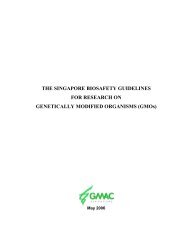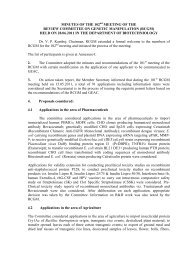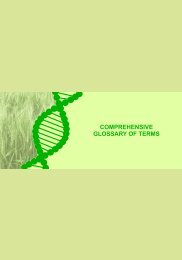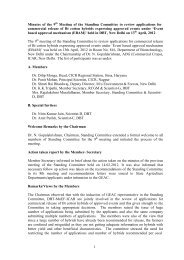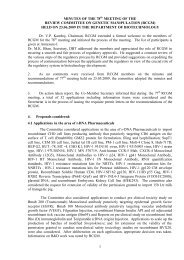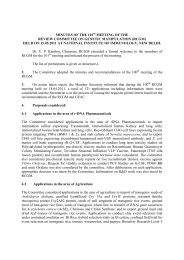THE USER'S MANUAL ON CODEX - Department of Biotechnology
THE USER'S MANUAL ON CODEX - Department of Biotechnology
THE USER'S MANUAL ON CODEX - Department of Biotechnology
Create successful ePaper yourself
Turn your PDF publications into a flip-book with our unique Google optimized e-Paper software.
When the Commodity Committee thinks that the general provisions are not sufficient, or are inadequate<br />
for a specific product, it may propose additional or different provisions in the relevant sections<br />
<strong>of</strong> the standard. These are referred to the competent subject matter Committee for consideration<br />
and endorsement. The appropriate general subject Committee would review what the Commodity<br />
Committee developed and <strong>of</strong>fer suggested changes, revisions and so on, if necessary, or endorse<br />
it as written.<br />
3.2 Food Additives and Contaminants Provisions<br />
When preparing a standard, Commodity Committees prepare a section on food additives containing<br />
all the necessary provisions for this specific standard. All authorized additives that are considered<br />
technologically necessary, or are widely permitted for use in food, are listed with a maximum level <strong>of</strong><br />
use expressed – for example, in mg/kg, g/kg or mg/l <strong>of</strong> product. Similarly, maximum levels are also<br />
proposed for major contaminants.<br />
When the text has been adopted as a draft standard (Step 5 <strong>of</strong> the procedure), the provisions relating<br />
to additives and contaminants established by the Commodity Committee are referred to the Codex<br />
Committee on Food Additives and Contaminants (CCFAC) for endorsement. In the case <strong>of</strong> food additives,<br />
the CCFAC determines whether or not the proposed use is consistent with the provisions <strong>of</strong> the<br />
Codex General Standard on Food Additives, in particular the General Principles for the Use <strong>of</strong> Food<br />
Additives, and whether the combined use <strong>of</strong> the additive in the commodity and all other food would<br />
pose a potential hazard for consumers’ health. The same procedure is followed with<br />
regard to contaminants.<br />
3.3 Methods <strong>of</strong> Analysis and Sampling<br />
Methods <strong>of</strong> analysis and sampling that are recommended by Codex are published in Volume 13 <strong>of</strong> the<br />
Codex Alimentarius. The section on Methods <strong>of</strong> Analysis and Sampling in the Codex Standard usually<br />
refers the reader to this volume for methods and sampling information rather than including the method<br />
in the standard itself. The Codex Committee on Methods <strong>of</strong> Analysis and Sampling (CCMAS) may<br />
develop methods that are <strong>of</strong> general application, and, in this case, is responsible for carrying out all the<br />
steps <strong>of</strong> the procedure for adopting the method as part <strong>of</strong> the Codex Alimentarius.<br />
Similarly, when a Commodity Committee proposes a method <strong>of</strong> analysis or a sampling procedure, the<br />
proposal must be referred to the CCMAS at Step 4 <strong>of</strong> the adoption process. This allows the Member<br />
Governments time to review and <strong>of</strong>fer comments on the proposal at the earliest stage in the development<br />
<strong>of</strong> the standard.<br />
The Codex Committees on Food Hygiene (microbiological methods), the Codex Committee on Food<br />
Additives (food additive specifications), and the Codex Committee on Pesticide Residues also elaborate<br />
methods <strong>of</strong> analysis and sampling. These methods are not referred to the CCMAS as the proposed<br />
methods originate from Codex Committees recognized for their competence in these fields.<br />
4. <strong>CODEX</strong> ACHIEVEMENTS AND CURRENT TRENDS<br />
4.1 Standards and Related Texts 2<br />
As <strong>of</strong> 2003, the Codex Alimentarius Commission had in place 237 adopted standards for food in all<br />
the main groups <strong>of</strong> food traded at the international level. Its commodity standards have been updated<br />
to align with contemporary trends for performance-based standards.<br />
Codes <strong>of</strong> Practice provide guidance on acceptable manufacturing and food processing and handling<br />
practices during production, transport and storage. The Codex Commission has elaborated 47 codes,<br />
2<br />
The number <strong>of</strong> Codex standards, codes, MRLs, MCPs, etc, are as at the conclusion <strong>of</strong> the 24th Session <strong>of</strong> the Commission (July 2001) and the<br />
Extraordinary Executive Committee meeting (September 2001).<br />
27


